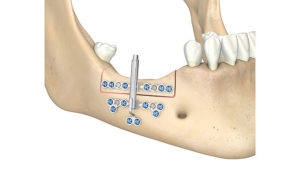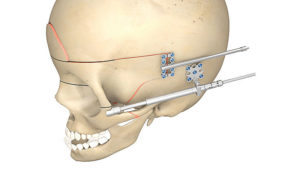Midface Distraction
In traditional craniofacial remodeling, there are creative techniques used to increase the volume and shape of existing bone, but generating bone and tissue through gradual distraction offers a reliable method to achieve treatment goals.
Cranial vault expansion and fronto-facial advancement by distraction osteogenesis has the big advantage of producing new autologous bone of correct shape in their locations, which is alive and vascularised. The technique, although not simple and not risk free, is much less technically challenging and exposes patients to lower risk for the most serious complications compared to single-stage vault expansion or monobloc advancement. Less soft tissue dissection and less devascularisation of bone are required thus minimising bone resorption and epidural dead space seen in traditional cranial remodeling. As the expansion is gradual, wound closure is not under tension resulting in less risk of problems with healing.
For in-depth information, documentation, key publications and specifications, head to the KLS Martin website here.
To chat with one of our team, or ask us a question, please get in touch. Call us on 0800 333 909 or email admin@orthomedics.co.nz.
Devices for distraction of the Alveolar Ridge
TRACK Distractors
Indications:
- Partial defects of the mandibular and maxillar alveolar crest
- Periodontal diseases with severe localized bone loss
- Localized atrophy of the alveolar crest
Features:
- Distraction length: 12 mm, 15 mm
- Distraction length/turn: 0.3 mm, 0.5 mm
- To be fixed with 1.0 mm / 1.5 mm Screws
Benefits:
- Available in different designs to treat all kind of alveolar defects
- Vector stabilizing plate to prevent tilting of the distractor body
Devices for use in correction of Craniomaxillofacial Malformations
Zurich Paediatric Maxillary Distractors
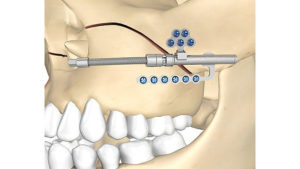
Indications:
The Zurich Maxillary Distractor is suitable for distracting the maxilla of infants and young adults in cases of congenital or acquired malformation, deficits and hypoplasia.
Features:
- Distraction length: 15 mm, 20 mm
- Distraction length/turn: 0.5 mm
- To be fixed with 1.5 mm Screws
Benefits:
- Available in different activator designs
Maxillary Distractors
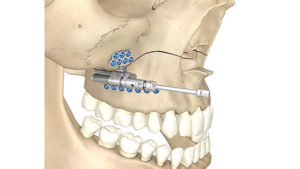
Indications:
The Maxillary Telescoping Distractor is suitable for distraction of the maxilla where gradual bone lengthening is required, particularly as a result of congenital and acquired malformations, deficits and hypoplasia.
Features:
- Distraction length: 30 mm
- Distraction length/turn: 0.35 mm
- To be fixed with 1.5 mm Screws
Benefits:
- The design allows maximum distraction length with minimum initial space requirements, as the distractor achieves its full extent only at the end of the distraction phase
- Symmetrical design, usable on patient´s right and left side
- Flexible activator concept
TS-MD Distractors
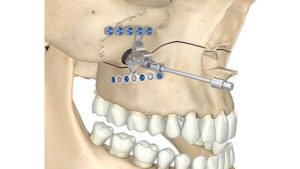
Indications:
- Treatment of moderate to severe maxillary and midfacial defi-ciency in cleft lip & palate patients
- Treatment of patients with class III dentofacial malocclusion at a much younger age (from 6 to 8 years)
- Treatment of maxillary hypoplasia with anterior open bite
- Correction of maxillary retrusion prior to the orthodontic treat-ment in class III malocclusion cases
Features:
- Distraction length: 20 mm, 25 mm, 30 mm
- Distraction length/turn: 0.5 mm
- To be fixed with 1.5 mm Screws
Benefits:
- The TS-MD distractor utilizes the maxillary sinus as space for the distraction spindle. The anatomy of the maxillary sinus causes no limitation in the choice of the vector of distraction, which is indicated by the position of the distraction spindle
- Symmetrical design, usable on patient´s right and left side
Liou Cleft Distractors
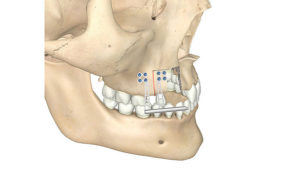
Indications:
The Liou Cleft Transport Distractor is intended for horizontal transport distraction of the maxillary alveolar ridge. The distractor enables segments to be transported unidirectionally for reconstruction of continuity defects, especially in the following cases:
- congenital alveolar clefts in cleft patients
- defects caused by removal of congenital or acquired alveolar crest fistulas and cysts
- congenital or acquired alveolar ridge deficiencies/defects
Features:
- Distraction length: 20 mm
- Distraction length/turn: 0.3 mm
- To be fixed with 1.5 mm Screws
Benefits:
- Possibility of extramucosal placement due to long plates
Devices for Transverse Palatinal Distraction
Rotterdam Palatal Distractors (RPD)
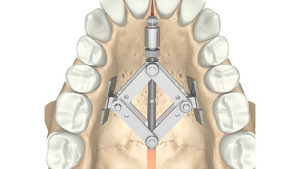
Indications:
- Extreme transversal, unilateral or bilateral maxilla crowdings in syndrome and non-syndrome patients
- Anterior tooth crowdings and buccal corridors (dead spaces)
Features:
- Distraction length: 19 mm
- Distraction length/turn: The Rotterdam Palatal Distractor works mechanically like a scissor-type jack, so the distraction length per turn decreases the higher the number of turns
- No screws needed
Benefits:
- Due to the scissor-type jack design, minimum initial space is required
Rapid Palatal Expander (RPE)
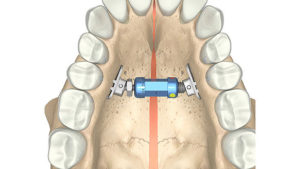
Indications:
- Extreme transversal, unilateral or bilateral maxilla crowdings in syndrome and non-syndrome patients
- Anterior tooth crowdings and buccal corridors (dead spaces)
Features:
- Distraction length: 9 mm, 18 mm, 27 mm, 36 mm
- Distraction length/turn up to the next color code: 0.33 mm
- To be fixed with 2.0 mm Screws
Benefits:
- Color coded according to distraction length
- Templates available for correct choice of distractor size
- Also available as sterile kit
External device for use in correction of Craniomaxillofacial Malformations
RED II Distractor
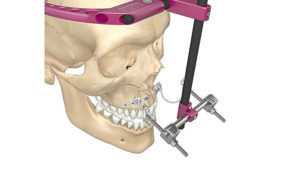
Indications:
Severe midface hypoplasia due to :
- severe transversal, vertical and / or horizontal deficits in the midface
- late sequelae of cheilognathopalatoschisis (clefts), especially in conjunction with velopharyngoplasties and also with hypodontia
- syndromes (e.g. Apert’s or Crouzon’s syndrome)
- maxillary retrognathia and atrophy
- obstructive sleep apnea
Features:
- Distraction length: unlimited
- Distraction length/turn: 0.5 mm
- To be fixed to the bone with pins
Benefits:
- Completely adjustable for any midfacial hypoplasia patient (Possibility to perform Le-Fort-I, II, III and monobloc distraction procedures)
- Force application only on the affected treatment region
- Unlimited distraction distances
Devices for use in correction of Craniofacial Malformations
Arnaud/Marchac Distraction System
Indications:
The Arnaud/Marchac Distraction System is intended for internal distraction when treating craniofacial dysplasia, especially craniofacial synostoses. It is used for patients requiring facial advancement (Le Fort III) or frontofacial (monobloc) advancement.
Features:
- Distraction length: 20 mm, 30 mm / 25 mm, 35 mm
- Distraction length/turn: 0.3 mm / 0.5 mm / 0.6 mm
- To be fixed with 1.5 mm / 2.0 mm Screws
Benefits:
- Symmetrical design, usable on patient´s right and left side
- Hooks fitted to the osteosynthesis plates distribute distraction force to the bone
- Flexible activator concept
Kawamoto Distractor
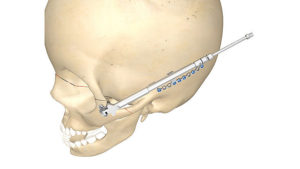
Indications:
The Kawamoto Midface Distractor is intended for internal distraction when treating craniofacial dysplasia, especially craniofacial synostoses. It is used for patients requiring facial advancement (Le Fort III) or frontofacial (monobloc) advancement.
Features:
- Distraction length: 30 mm
- Distraction length/turn: 0.5 mm
- To be fixed with 1.5 mm Screws
Benefits:
- Available in 2 different versions for a perfect fit to every patient´s anatomy
- Symmetrical design, usable on patient´s right and left side
- Swivel joint footplate allows compensation of any occurring forces when the force vector changes
- Flexible activator concept
